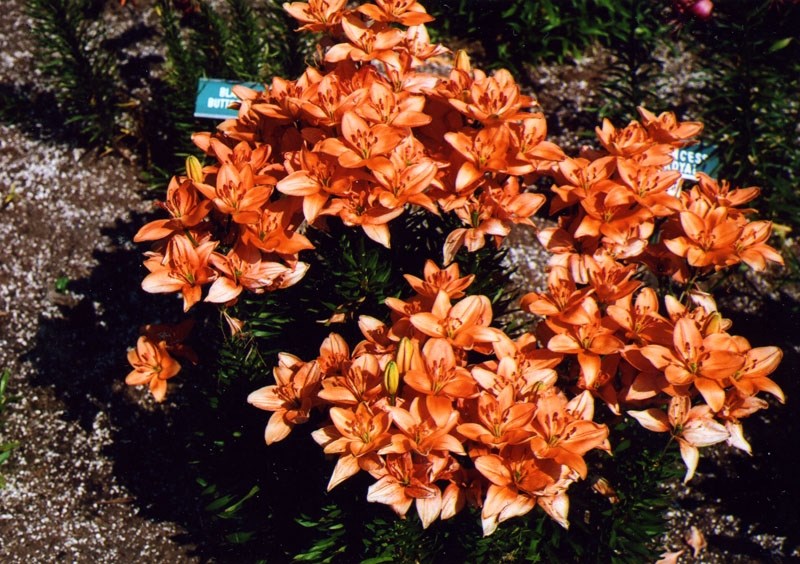Anyone starting to plan their summer garden should take time to consider the lilies of the field. Lilies are easy to grow and they will bloom perennially for many years to come.
Anyone starting to plan their summer garden should take time to consider the lilies of the field. Lilies are easy to grow and they will bloom perennially for many years to come.
Some 40 years ago, as a novice gardener, I discovered the beauty and ease of growing Asiatic lilies.
I remember carefully planting that first group of yellow Asiatic lilies in the fall, beside the tulip bulbs. That first batch of tulips is long gone, but the lilies still come up and still bloom every July.
Since then I've discovered that these types of lilies almost thrive on neglect and poor soil. One spring I found several bulbs had heaved up with the frost and lay on top of the driest soil, right next to the house foundation. They still grew! They bloomed!
Lilies are very flexible. You can plant the bulbs in the fall, or move them and transplant them in the spring. If you discover little black baubles on the lily stems, remove them and plant them and in about three years you will have even more lilies. Or take the bulbs themselves and split them apart and plant the little scales and soon you will have a sea of cloned lilies.
In this area the easiest lilies to grow are the Asiatic varieties, the martagon lilies and the Oriental lilies. All three varieties are grown at the St. Albert Botanic Park, with the largest, most dramatic flowerbeds devoted to the Asiatic lilies. The scented varieties, such as Star Gazer, are Oriental lilies.
"There are 30,000 varieties of Asiatics in cultivation in the world. We have fewer than 300 varieties, so really, we have just a sampling of them at the botanic bark," said John Beedle, who designed the lily beds when he drew up the first plans for the park.
Beedle maintains that though Asiatic lilies are easy to grow, they produce better blossoms if they are dug up every third year and replanted.
"They do better if they are replanted because over time they wear the soil out. Dig the hole and put some bone meal in the bottom along with three bulbs, which will come up as a bush," he said.
If you have trouble with allergies, you might try growing the Dan Dale variety of orange Asiatic lilies, which have been hybridized so they do not have stamens, and therefore produce no pollen.
One variety that grows prolifically is the Lollipop variety, which is a white lily with a pink outline on the petals. The bulbs reproduce themselves readily and even if you plant just a few, within a year or two you will have an entire garden full of July-blooming pink and white blossoms.
Some varieties of tiger lilies are also easy to grow, but be wary of transplanting the native wood lily.
"Tiger lilies are protected flowers," said Tam Andersen, of Prairie Gardens and Greenhouses, who explained that if you pick the flowers of a tiger lily, the plant will die because it cannot get enough nourishment through its leaves to sustain the bulb.
Nonetheless, the words "tiger lily" have come to mean any orange speckled lily and many are available through greenhouses. One six-foot tall tiger lily is growing in the Cottage Garden at the botanic park.
Horticulturalist Ieuan Evans has hybridized several varieties of martagon lilies on his acreage near Stony Plain. He maintains that the martagons are the easiest of all varieties to grow and once they become established will live 50 years or longer.
"Most of the martagon gene pool comes originally from Siberia, so they are very hardy here. They do best in sandy soil and will grow best in a half-shady place," Evans said. "They do well in a woodlot and if you plant them in among the trees you'll find them popping up here and there all over the woods."
For the most part, martagon lilies have down-facing blossoms, although Evans is working on hybridizing lilies with side-facing blooms. The martagons grow between three and eight feet in height.
Evans has bred two martagon lilies especially for the St. Albert Botanic Park. One, the St. Albert Martagon, is a pink/burgundy. The second, named for former city councillor Margaret Plain, is dark burgundy. A third lily, named for the late Lois Hole, is a bright lemon yellow coloured lily and was bred by Marvin Joslin.
"We have started growing them in the botanic park and in a few years, when we have enough of them, we'll sell them as a fundraiser for the park," said long-time park supporter and former mayor Richard Plain.
Editor's note: The original version of this story incorrectly identified Ieuan Evans as the hybridizer who developed the Lois Hole lily. The flower named in honour of the late Lois Hole was developed by Marvin Joslin. The Gazette apologizes for the error.
